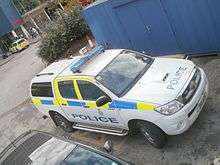Port of Liverpool Police
| Port of Liverpool Police | |
|---|---|
 | |
| Agency overview | |
| Formed | 1975 |
| Jurisdictional structure | |
| Operations jurisdiction |
Port of Liverpool, |
|
| |
| Map of Port of Liverpool Police's jurisdiction. | |
| Size | 181 km² |
| Population | Port staff and passengers |
| Headquarters | Liverpool Freeport |
|
| |
| Sworn members | 46[1] |
| Agency executive |
|
| Divisions | 7 |
| Facilities | |
| Stations | 2 |
| Website | |
| Force web site | |
The Port of Liverpool Police is a small police force with the responsibility of policing the Liverpool, Bootle, Birkenhead, Ellesmere Port and Eastham Dock Estates and Freeports, as well as the Manchester Ship Canal areas in the north- west of England.
Mandate
The Port of Liverpool police is accountable to the Department for Transport. Its officers receive their long service and good conduct medals from the department.[2]
Role, function and organisation
The Port of Liverpool Police is established under the Mersey Docks and Harbour (Police) Order 1975.[3] This legislation sets out that constables of the force hold the full powers of the office of constable within the port police area, which is defined as the port and any place within 1 mile of the limits of the port.[4] The Marine Navigation Act 2013 provides a limited extension to this jursidiction if a Chief Constable of a police area consents. This allows port police officers to use police powers in relation port area policing matters anywhere in the police area where consent has been granted - it does not grant full police powers in relation to non port policing matters.[5] As of July 2014, Port of Liverpool Police were applying to the Chief Constable of Merseyside for such consent within Merseyside police area.[6] The force employs under 50 police officers, of whom five comprise the criminal investigation department.[7][8]
Vehicles
The force has a number of cars and vans, several dog units and a river patrol boat.
Rank structure
The rank structure of the Port of Liverpool Police is smaller than that used in most UK police forces, as shown below.
- Chief officer (The post is currently held by Martin Humphreys)[9][10]
- Superintendent (deputy chief officer)
- Sergeant
- Constable
As with Home Office police force, officers are required to sit and pass the OSPRE promotion examinations to be considered for promotion to sergeant and inspector.[11] Further promotion within the force falls down to selection, merit and budget allowance.
History
In its present form, the force has existed since 19 June 1975, when it was created by The Mersey Docks and Harbour (Police) Order, statutory instrument No. 1224 of 1975. The dock has had a dedicated police force throughout its history, though not always constantly:
- From 1811- 37, the Liverpool Dock Police patrolled much the same area until its merger with the Liverpool Borough Police Force
- In 1852, 40 officers were transferred to the Liverpool Fire Brigade for the purpose of policing the docks[12]
- In 1865 the River Mersey Police took responsibility for policing these areas until 1920, after which they were policed by territorial forces
- In 1975, with the passing of the above SI, the current body was formed. It became fully operational in July 1976[13]
The Manchester Ship Canal had a separate police force, the Manchester Ship Canal Police, from its founding in 1893 until 1993.[14]
Jurisdiction
The force has jurisdiction over the whole of the Port of Liverpool as defined by the Mersey Docks and Harbour Act 1971 and its amendments. However Merseyside Police, as the territorial police force with statutory responsibility for policing the whole of Merseyside has concurrent jurisdiction in the port area.
The Port of Liverpool Police has entered into a memorandum of understanding with Merseyside Police, which sets out how the two forces operate together and the use of certain resources, for example, Merseyside Police custody facilities.[15] The port police responds to the report of all crimes and emergencies within the port area. However, as per the memorandum, Merseyside Police will take over the handling of the following matters whilst assisted by the Port of Liverpool Police:
- Murder
- Rape
- Serious Life Threatening Assaults
- Armed Crime
- Crime requiring significant or specialist resources to investigate
- Fatal Traffic Collisions
- Large Scale Disorder
- Terrorism and Subversion
- Extradition Matters[16]

See also
References
- ↑ "Archived copy". Archived from the original on 13 May 2010. Retrieved 22 August 2011.
- ↑ http://www.dft.gov.uk/pgr/shippingports/ports/accountabilityreview?page=2#a1005
- ↑ Department for Transport, Great Minster House (1970-01-01). "Accountability and Standards of the Port Police Forces". Archived from the original on 2010-06-05. Retrieved 2017-11-19.
- ↑ "The Mersey Docks and Harbour (Police) Order 1975". www.legislation.gov.uk. Retrieved 2017-11-19.
- ↑ "Marine Navigation Act 2013". www.legislation.gov.uk. Expert Participation. Retrieved 2017-12-20.
- ↑ "Marine Navigation Act 2013 - Consent by Chief Constable re Ports Police - Written Question 203891 - a Freedom of Information request to Department for Transport". WhatDoTheyKnow. 2017-11-20. Retrieved 2017-12-20.
- ↑ "Archived copy". Archived from the original on 11 May 2009. Retrieved 15 April 2009.
- ↑ "Archived copy". Archived from the original on 11 May 2009. Retrieved 15 April 2009. (support)
- ↑ http://www.shipcanal.co.uk/news/2008/09.htm
- ↑ http://www.portofliverpool.police.uk/
- ↑ "Archived copy". Archived from the original on 16 February 2009. Retrieved 15 April 2009.
- ↑ http://www.merseyfire.gov.uk/aspx/pages/history/history.aspx
- ↑ http://www.portofliverpool.police.uk/
- ↑ "Manchester Ship Canal Police". Magazine of the Police Memorabilia Collectors Club (149). 13 August 2010.
- ↑ "Archived copy". Archived from the original on 11 May 2009. Retrieved 15 April 2009.
- ↑ Department for Transport, Great Minster House. "Accountability and Standards of the Port Police Forces". Archived from the original on 2010-06-05. Retrieved 2017-11-19.
External links
- Official website Note link opens Peel Ports - then search for Police.
- Images of the Port of Liverpool Police on Flickr
| Wikimedia Commons has media related to Port of Liverpool Police. |
